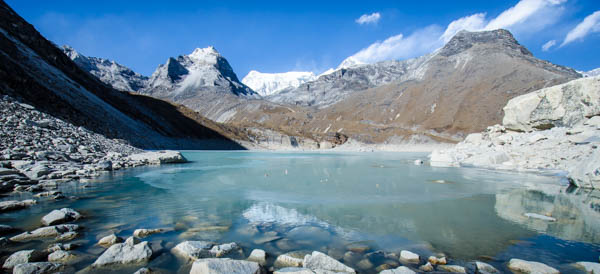EBC Day 04 – Lukla to Phakding
EBC Index
The Town of Lukla

 After claiming our bags that we had checked in and leaving the Tenzing-Hillary Airport (Nepali : तेन्जिङ-हिलारी बिमानस्थल)
After claiming our bags that we had checked in and leaving the Tenzing-Hillary Airport (Nepali : तेन्जिङ-हिलारी बिमानस्थल) ![]() , we walked through the village of Lukla that was basically a bunch of teahouses, cafes and eateries, small shops selling a wide variety of items to cater to the needs of all the hikers that passed through the area, as well as a few pubs here and there, that lined the main road. I had to purchase another snow cap here for NPR400 as I had somehow managed to misplace mine.
, we walked through the village of Lukla that was basically a bunch of teahouses, cafes and eateries, small shops selling a wide variety of items to cater to the needs of all the hikers that passed through the area, as well as a few pubs here and there, that lined the main road. I had to purchase another snow cap here for NPR400 as I had somehow managed to misplace mine.
The many teahouses that we were to encounter as we trekked through the region were to become very familiar to us as these teahouses were to provide us the food and hot drinks, as well as the rooms that were to shelter us from the elements at night. Teahouse trekking is a type of trekking that gives trekkers the option of traveling light since the loads that each trekker has to carry does not include large amounts of food and ingredients, nor any camping gear. Nevertheless, the weight of my backpack reached 16kg which was most likely attributable to the laptop and all the electronics that I had brought along with me. That along with all my camera gear meant that I would be trekking with close to 20kg for the weeks that were to come.
The area, known as Khumbu, is home to the famous Sherpas but the region is probably better known for the wide variety of famous treks that can be found here. The village of Lukla is the starting point for many of these, including the Everest Base Camp (EBC) trek, the trek to the village of Gokyo that is famous for its lakes, as well as the trek to the three high-altitude mountain passes (Kongma La, Cho La, and Renjo La) that I was planning to do. Lukla is also the starting point for treks to some of the summits such as Island Peak and Mera Peak that are more technical that need both specialized gear and skills.
Most of the Sherpa villagers in the region used to make regular trips over the Nangpa La Pass for trade before China closed the border in 1959 after suppressing a Tibetan uprising. Since then the Sherpa community has had to embrace travel and tourism as there is not much else that can sustain them in a region this remote.
The first day of trekking was a remarkably easy one as most of the trek was downhill with a descent of 369 m and an ascent of only 200 m. The next village, Phakding (elevation : 2610 m), is only about 7 kilometres away and the trek there takes two hours and a half. The fact that the trek was not physically demanding allowed me to immerse myself in the gorgeous scenery that surrounded me. Amongst the bushes of rhododendrons (Rhododendron spp.) and the fields of buckwheat (Fagopyrum esculentum), dzos ('dzomos' for the female counterpart), which are a hybrid of yak (Bos grunniens) and domestic cattle (Bos taurus), would pass by with huge loads secured to their backs. It was still a few days before I was to encounter my first yak as they are typically found at higher elevations.

One thing that I feel that I have to mention about both dzos and yaks is that when you hear their bells clanking as they approach, you had best move out of their way and away from the edge of the cliff as they tend to just keep on moving forward. I actually heard some stories about trekkers getting pushed off the mountain by yaks but have not been able to verify their authenticity. Just a word of warning.
Mani Stones
I also encountered a large number of mani stones along the way, and passed them on the left (going around them in a clockwise direction) as Tibetan Buddhists apparently believe that the Universe 'spins' in that direction. The mani stones are so named because of the six syllable mantra of Avalokiteshvara engraved on them. This very common mantra (when transliterated is 'Om mani padme hum' - the first four, 'Om ma ni pad' are represented by the last four Sanskrit symbols on the lower left of the rock in the image above) has a meaning that is quite complex and not very easy to define. To make things (much) easier for myself, I am going to resort to quoting the words of the 14th Dalai Lama, who had this to say about them :
It is very good to recite the mantra Om mani padme hum, but while you are doing it, you should be thinking on its meaning, for the meaning of the six syllables is great and vast... The first, Om [...] symbolizes the practitioner's impure body, speech, and mind; it also symbolizes the pure exalted body, speech, and mind of a Buddha[...]
The path is indicated by the next four syllables. Mani, meaning jewel, symbolizes the factors of method: (the) altruistic intention to become enlightened, compassion, and love.[...] The two syllables, padme, meaning lotus, symbolize wisdom[...] Purity must be achieved by an indivisible unity of method and wisdom, symbolized by the final syllable hum, which indicates indivisibility[...] Thus the six syllables, om mani padme hum, mean that in dependence on the practice of a path which is an indivisible union of method and wisdom, you can transform your impure body, speech, and mind into the pure exalted body, speech, and mind of a Buddha[...]

Phakding
The teahouse that we ended up staying in Phakding
Since temperatures that night were apparently around -13 degrees Celsius, after dinner the group kept warm by clutching mugs of hot beverages whilst chatting and sitting around the dung-burning heater in the common room, before reluctantly retiring to our frigid beds for the night.
Route Playback
Suunto Movescount Stats
Day 4 Expenditure







The picture of the valley and the clouds taken below the place is simply amazing. Thank you sharing your article.
Thanks for the compliment Shishir 🙂